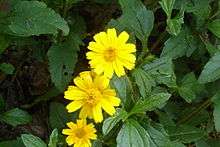Sphagneticola trilobata
Sphagneticola trilobata, commonly known as the Bay Biscayne creeping-oxeye,[3] Singapore daisy, creeping-oxeye, trailing daisy, and wedelia,[4][5] is a plant in the Heliantheae tribe of the Asteraceae (sunflower) family. It is native to Mexico, Central America, and the Caribbean, but now grows throughout the Neotropics. It is widely cultivated as an ornamental groundcover.[6]
| Sphagneticola trilobata | |
|---|---|
 | |
| Scientific classification | |
| Kingdom: | |
| (unranked): | |
| (unranked): | |
| (unranked): | |
| Order: | |
| Family: | |
| Genus: | |
| Species: | S. trilobata |
| Binomial name | |
| Sphagneticola trilobata | |
| Synonyms | |
|
Complaya trilobata (L.) Strother | |
Description
Spreading, mat-forming perennial herb up to 30 cm in height. Has rounded stems up to 40 cm long, rooting at nodes and with the flowering stems ascending. Leaves are fleshy, hairy, 4–9 cm long and 2–5 cm wide, serrate or irregularly toothed, normally with pairs of lateral lobes, and dark green above and lighter green below. Peduncles are 3–10 cm long; involucres are campanulate to hemispherical, about 1 cm high; chaffy bracts are lanceolate, rigid. The flowers are bright yellow ray florets of about 8-13 per head, rays are 6–15 mm long; disk-corollas 4–5 mm long. The pappus is a crown of short fimbriate scales. The seeds are tuberculate achenes, 4–5 mm long. Propagation is mostly vegetatively as seeds are usually not fertile.[7]
Habitat
It has a very wide ecological tolerance range, but grows best in sunny areas with well-drained, moist soil at low elevations.[8]
Invasive Species
Sphagneticola trilobata is listed in the IUCN's “List of the world's 100 worst invasive species”.[9] It is spread by people as an ornamental or groundcover that is planted in gardens, and then it is spread into surrounding areas by dumping of garden waste. It spreads vegetatively, not by seed. It rapidly forms a dense ground cover, crowding away and preventing other plant species from regenerating. This species is widely available as an ornamental and is therefore likely to spread further.
It is a noxious weed in agricultural land, along roadsides urban waste places and other disturbed sites. It is also invasive along streams, canals, along the borders of mangrove swamps and in coastal vegetation.
It is widespread as an invasive species on the Pacific Islands, Hong Kong, South Africa, Australia, Indonesia, and Sri Lanka. [10]
Gallery
See also
References
- "Taxon: Sphagneticola trilobata (L.) Pruski". Germplasm Resources Information Network. United States Department of Agriculture. 2000-11-28. Archived from the original on 2011-06-29. Retrieved 2011-02-16.
- "Sphagneticola trilobata (herb)". Global Invasive Species Database. Invasive Species Specialist Group. 2007-05-31. Retrieved 2010-06-07.
- "Sphagneticola trilobata". Natural Resources Conservation Service PLANTS Database. USDA. Retrieved 25 November 2015.
- ”Sphagneticola trilobata” , Pacific Island Ecosystems at Risk (PIER) website, http://www.hear.org/pier/species/sphagneticola_trilobata.htm
- "Sphagneticola trilobata". Integrated Taxonomic Information System. Retrieved 2011-02-16.
- ”Sphagneticola trilobata (herb)”, Global Invasive Species Database website, at http://www.issg.org/database/species/ecology.asp?si=44
- ”Sphagneticola trilobata” , Pacific Island Ecosystems at Risk (PIER) website, http://www.hear.org/pier/species/sphagneticola_trilobata.htm Lalith Gunasekera, Invasive Plants: A guide to the identification of the most invasive plants of Sri Lanka, Colombo 2009, p. 117–118.
- ”Sphagneticola trilobata (herb)”, Global Invasive Species Database, at ” Sphagneticola trilobata (wedelia)” Invasive Species Compendium website, at http://www.cabi.org/isc/?compid=5&dsid=56714&loadmodule=datasheet&page=481&site=144
- http://www.iucngisd.org/gisd/pdf/100English.pdf
- ”Sphagneticola trilobata” , Pacific Island Ecosystems at Risk (PIER) website, http://www.hear.org/pier/species/sphagneticola_trilobata.htm ”Sphagneticola trilobata (herb)”, Global Invasive Species Database website, at http://www.issg.org/database/species/ecology.asp?si=44 ”Singapore daisy”, Invasive Species South Africa website, at http://www.invasives.org.za/invasive-species/item/345-singapore-daisy-sphagneticola-trilobata.html Lalith Gunasekera, Invasive Plants: A guide to the identification of the most invasive plants of Sri Lanka, Colombo 2009, p. 117–118. ” Sphagneticola trilobata (wedelia)” Invasive Species Compendium website, at http://www.cabi.org/isc/?compid=5&dsid=56714&loadmodule=datasheet&page=481&site=144
Further reading
External links



_at_Lotus_Pond%2C_Hyderabad%2C_AP_W_IMG_7641.jpg)

_at_Lotus_Pond%2C_Hyderabad%2C_AP_W_IMG_7640.jpg)